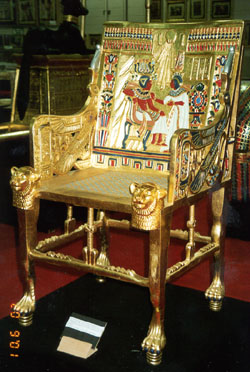| The
Treasure of King Tut is a beautiful educational exhibit with Egyptian
treasures and artifacts featuring treasures of King Tut and many beautiful
pieces of history. |
| |
| VIEW
ONLINE EXHIBIT |
| SHOW
REFERENCES |
| SHOW
REQUIREMENTS |
| PICTURES
AND DESCRIPTIONS OF THE KING TUT EXHIBIT |
| ADDITIONAL
PICTURES OF KING TUT EXHIBIT |
| |
Great
interest in ancient Egyptian civilization arose in modern times following
Napoleon Bonaparte's expedition to Egypt in 1798. The Egyptian museum
houses the largest and most important material sources on ancient
Egyptian civilization. The most important monuments in the Egyptian
museum are the treasures of King Tutankhamon. In 1980 the treasures
of King Tut were displayed in San Francisco. After this trip to San
Francisco the Egyptian Authorities decided the treasures would not
leave the Egyptian museum. Fortunately the Egyptian Art Center, a
private Egyptian Company, began a project to produce exact replicas
of the King Tut Treasures to be displayed outside of Egypt. These
wonderful treasures have been displayed in Japan, Canada, and the
USA. Now Capitol International Productions has made arrangements with
The Egyptian Art Center to bring these incredible artifacts to your
event.
|
 |
THE
SECOND COFFIN OF KING TUTANKHAMUN
The
second of three anthropoid coffins. The larger one in its original
place in Thebes. Attributes as on the innermost coffin. Wood coated
with gold and inlaid with polychrome glass. It is hard to believe
the amount of work required in order completing this coffin. The
carved wood was first overlaid with sheet gold on a thin layer of
plaster. Narrow strips of gold, placed on the edge, where then soldered
to the sheet gold in order to form cells in which small pieces of
colored glass, fixed with cement were laid. The technique is known
as Egyptian
cloisonne work.
|
|
 |
A
WOODED SMALL CHAIR
Probably
for the king when he was a child, is carved of wood and inlaid with
ivory. It has antelope and floral deices of embossed copper on the
panels and the arms. Net weight 12 Kg.
|
|
 |
THE
GOLDEN THRONE OF KING TUTANKHAMUN
A
magnificent chair of wood coated with gold, with a rich polychrome
decoration of faience, glass, semi-precious stone and silver. Net
weight 30Kg.
|
|
 |
THE
BURIAL COACH IN THE FORM OF A DIVINE COW
The
bed is made of wood, coated with gold, the disc of the sun between
the lyre form the horns of the Divine Cow identifies the Goddess
Hathor. Net weight is 75 Kg.
|
|
 |
ORNAMENTAL
ALABASTER BOAT
Inlaid
with colored pigments. The cabin has the shape of a shrine and is
guarded by a dwarf with deformed feet. The horns of the ibices are
from young animals.
|
|
 |
FUNERARY
STATUETTES
These
figures are in two kinds:
(1)
Small statuettes, often mummies form in shape, with or without inscriptions.
When inscription are found on them, they usually give the name and
titles of the deceased together with a prayer for offerings.
(2)
Small figures, often enclosed in model coffins, inscribed with a
magical text.
They
were called Shawabti.
|
|
|

|
STATUE OF PRINCE RAHOTEP AND PRINCES NOFRET
Painted
limestone statue of prince Rahotep, general high priest of Heliopolis,
They were members of the royal family.
The
lifelike expressions are so strongly marked that the worker fled
while uncovering the statue.
(4th Dynasty 2723-2563 B.C.)
|
